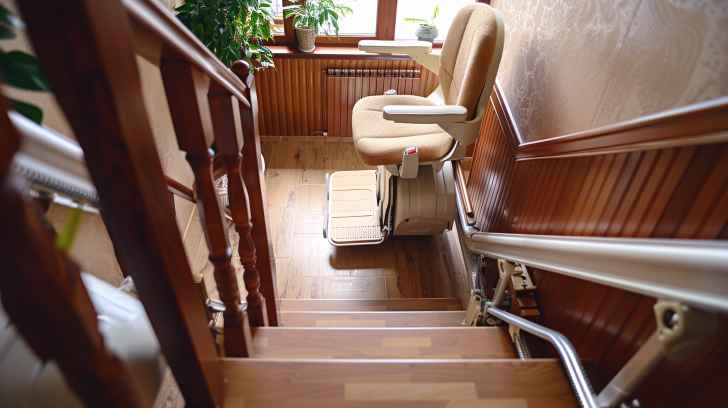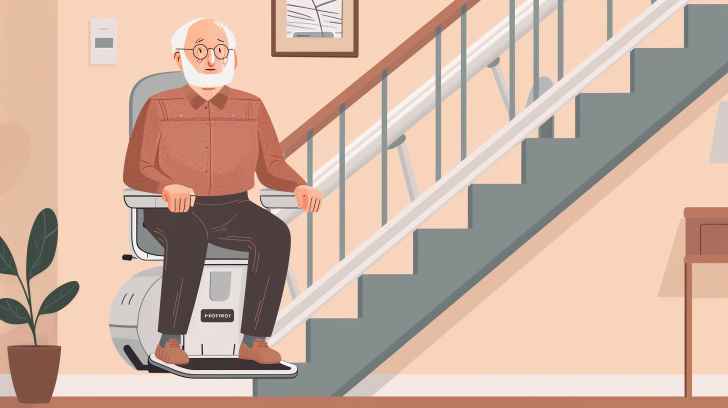Over 6.8 million people in America use mobility aids. This makes the question of whether stair lifts get Medicare coverage very important. It’s a big issue for the country’s older folks. Even though these devices are crucial for independent living and help those with functional limitations, seniors may be shocked to find out Original Medicare might not cover them. Stair lifts make homes safer and reduce fall risks, but they’re not clearly classified as durable medical equipment.
Medicare Part B helps cover assistive devices that are medically necessary and prescribed by a doctor. But, it usually doesn’t cover stair lifts, seen as home modifications. This leaves many seniors and people with chronic conditions looking for other ways to maintain their quality of life while aging in place. Yet, there’s still hope. Medicare Advantage and certain supplemental plans might offer better options, covering fall prevention and mobility assistance.
It’s crucial to look closely at Medicare, Medicaid, and private health insurance specifics. This can reveal ways to get financial help for crucial mobility aids like stair lifts. They are essential for safe, comfortable, and independent living for those in need.
Key Takeaways
- Stair lifts are not consistently covered under Original Medicare due to their classification as home modifications.
- Medicare Part B covers some durable medical equipment, but this does not standardly include stair lifts.
- Medicare Advantage and supplemental plans may offer expanded coverage for stair lifts under certain conditions.
- Medicaid coverage for stair lifts varies by state, and private insurance may partially cover the costs.
- Investigating local Medicaid offices and insurance plans can lead to financial assistance options for purchasing a stair lift.
Understanding Medicare’s Coverage of Stair Lifts

Original Medicare is important for seniors needing mobility help, but it has specific rules for stair lifts. Stair lifts help people move through multi-level homes. Sadly, they are not often seen as durable medical equipment by Medicare. This makes getting them a bit tricky for those who need these aids.
Defining Durable Medical Equipment and Where Stair Lifts Stand
For Medicare, durable medical equipment (DME) must be doctor-prescribed for home use and meet certain coverage criteria. But, stair lifts are viewed as home modifications, not medical equipment. Thus, they’re not covered by typical Original Medicare plans. This means people usually have to pay themselves or look for other funding.
Assessing Medical Necessity: A Key Requirement for Coverage
A doctor’s prescription is crucial for Medicare to cover any equipment. It must show that the equipment is medically necessary. However, stair lifts usually don’t meet the strict requirements for durable medical equipment. So, despite their clear benefits for mobility, they are hard to get covered.
The Role of Medicare Advantage and Supplemental Plans
If Original Medicare doesn’t cover something, Medicare Advantage and supplemental plans might help. They can cover accessibility equipment like stair lifts under certain conditions. People with these plans should carefully check their policy and talk to their provider. It’s a good way to find out about coverage and any extra benefits for house safety and moving around more easily.

Getting info on what Medicare-approved suppliers offer can help find equipment at a lower cost, or even for free. This points to the need for talking to suppliers that know a lot about Medicare’s coverage rules.
The Impact of State Policies on Medicaid and Stair Lifts
In the US, Medicaid and state policies offer different kinds of help for people needing stair lifts. These tools are crucial for people who want to live on their own but have trouble moving around. The process to get Medicaid to pay for these needed items varies from state to state. Some states cover the full cost if the stair lifts are really needed for health and safety. This kind of help can greatly improve the lives of people, letting them stay in their homes safely and comfortably.
Knowing the specifics of Medicaid in your state is key for finding financial help for home changes. Medicaid does not always pay for stair lifts, so it’s wise to look into other money options. This could mean using home equity, getting a reverse mortgage, or seeking out federal assistance from the Older Americans Act. In Ohio, for instance, programs like the Home Care Waiver and PASSPORT help with costs for necessary home updates. These local efforts offer hope and support beyond what you might get from Medicare or basic Medicaid.
Sometimes, renting a stair lift is a smarter choice for short-term needs. Talking to your local Medicaid office can help you find out what aid is available in your state. This way, you can look into all your options for financial help. Addressing state policies, Medicaid, and all possible financial support is vital. It helps improve life quality and keep independence for those with mobility issues at home.

FAQ
Are stair lifts covered by Medicare?
Original Medicare doesn’t usually cover stair lifts, as they’re seen as home changes, not durable medical gear. Yet, some Medicare Advantage or supplemental plans might offer exceptions that cover stair lifts. It’s best to look into your policy’s details and talk to your insurance provider.
What qualifies as durable medical equipment under Original Medicare’s coverage?
Items like wheelchairs, hospital beds, and walkers count as durable medical equipment (DME). To be DME, items must be needed for an illness or injury, prescribed by a doctor, and usable at home. They’re made for repeated use and have a medical purpose.
How does one demonstrate ‘medical necessity’ for equipment coverage under Medicare?
A healthcare provider must say the equipment is needed for treating or managing an illness. The needed paperwork has to show how the equipment helps with functional limits or manages a chronic condition.
What role do Medicare Advantage and supplemental plans play in covering stair lifts?
These plans might cover more than Original Medicare, including some home modifications or different DME. Coverage for stair lifts depends on medical necessity and a healthcare provider’s prescription. Always check your plan or talk to your insurance for details.
How does Medicaid handle coverage for stair lifts?
Medicaid’s coverage for stair lifts changes by state. Some states might help pay for stair lifts if needed for health and living independently. Check with your local Medicaid office for your state’s rules and any available financial help.
Are there alternative options for financial assistance to cover the cost of stair lifts?
Yes, some ways to help pay include home equity lines, reverse mortgages, grants, and federal programs. Ohio’s Home Care Waiver and PASSPORT programs are examples that may help. Some stair lift providers might also have rental or financing plans to make it easier to afford.
Can stair lifts be tax-deductible?
If a stair lift is needed for someone with a disability or health condition, it might be tax-deductible. Talking to a tax expert can help you know if your stair lift purchase meets IRS guidelines for a deduction.
What are the safety features to look for in a stair lift?
Look for a seatbelt, sensors for obstacles, a swivel seat, a locking system, and power backup. Also, check for easy controls and safety standard compliance. These features help ensure safety and meet different needs.
Do stair lifts have weight capacity limits?
Yes, stair lifts do have weight limits. It’s vital to pick one that can safely carry the user’s weight. This prevents equipment damage and injuries.
Is it possible to install stair lifts on both straight and curved staircases?
For sure. There are stair lifts for both straight and curved stairs. Curved staircases might need custom stair lifts, while straight ones often work with standard models.






